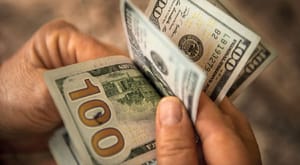
According to the director of the Office of Management and Budget, the top 20% of earners now pay 95% of all income taxes. Just two years ago, the figure was 84% of all income taxes paid by the top 20%.
For some context, the top 20% earn “only” about 51% of national income in a given year. In other words, they’re paying out of proportion to the percent of total income they earn (which is to be expected with a progressive income tax).
According to the Washington Examiner, “In explaining the complicated tax system the administration and congressional Republicans are trying to simplify, OMB Director Mick Mulvaney played the role of professor at Georgetown University Wednesday night and dished the eye-popping numbers and impact of a middle class tax cut. When the two turned to the taxes the rich pay, Mulvaney declared, ‘The top 20 percent of folks who file a tax return, the top 20 percent, pay 95 percent of the taxes.'”
Mulvaney explained: “If you break the income tax universe into what we call quintiles, so equal sized 20 percent columns, the first two columns, the first quintile and the lower quintile, don’t pay any taxes at all. In fact they net positive. We pay them when they file a tax return.”
Mulvaney then addressed an inevitable talking point that you’ll hear made against the Trump tax plan: That tax cuts are disproportionately “for the rich.” It’s one we addressed last week with the following thought experiment: Suppose tax reform boosted everyone’s income by 10%. Even if everyone benefited the same in terms of percentage gain, the top 1% would garner most of the gains. Let’s look at an example. The top 1% of U.S. households earned an average income of $1,153,298 in 2013, compared to $52,250 for the median U.S. household. If everyone got a 10% boost in income, the top 1% would gain $115,329, compared to “only” $5,225 for the median household – which we sincerely doubt they’d have a problem with.
Mulvaney added to a similar point as we made above that the structure of a progressive tax system also means that the rich would “disproportionately” benefit from tax cuts, even if everyone’s taxes were cut except the top bracket. “We have a progressive tax system, which means that if you make $1 million and I make $50,000, we both pay the exact same rate on the first, let’s say, $20,000. And then, from the next $20,000 up to my $50,000, and her next $20,000 to her next $50,000, we pay the same, I think it’s 12 percent of 15 percent, I can’t remember where the brackets are right now. And then she goes on to pay her higher rate on the stuff that she makes and I stop,” Mulvaney explained.
“Well, if you want to give me, the middle class, a cut, take my 15 percent rate down to say 10 percent, and that gives the middle class a cut. Guess who else benefits from that, she does. She pays that same rate on the way up the brackets,” he concluded.
A decrease in tax rates won’t be the only way that the middle class benefits from tax reform.
According to the Heritage Foundation, the President’s Council of Economic Advisors recently released a report showing that updating the U.S. business tax code to compete with other countries around the world could boost worker’s wages by $4,000, and as much as $9,000 a year.
Share this story if you think it’s time for tax cuts!
